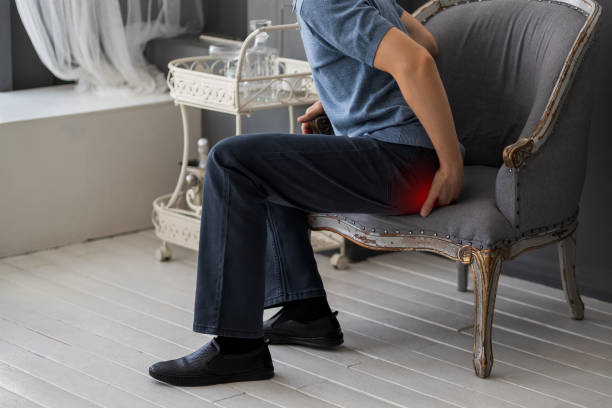Back
Understanding Pelvic Pain in Sitting for Men: Causes and How Pelvic Floor Physical Therapy Can Help
By Dr. Christine Martirez PT, DPT on 8/6/2024

Pelvic pain in sitting can often be debilitating and impact daily life. Understanding the underlying causes of pelvic pain in men and the role of pelvic floor therapy can provide relief and improve quality of life. In this blog post, we’ll explore the anatomy of the pelvic floor muscles in men, potential causes of pelvic pain while sitting, and how pelvic floor therapy can help manage and alleviate these symptoms.
Anatomy of the Pelvic Floor Muscles in Men
The pelvic floor muscles form a hammock-like structure at the base of the pelvis, providing support to the pelvic organs and assisting in various functions, including urination, bowel movements, and sexual activity. The primary muscles of the male pelvic floor include:
Pubococcygeus:
Supports the pelvic organs and helps control the flow of urine and feces.
Puborectalis:
Plays a crucial role in maintaining continence and supporting the rectum.
Iliococcygeus:
Supports the pelvic organs and contributes to pelvic floor stability.
Coccygeus:
Supports the pelvic organs and stabilizes the coccyx.
Obturator Internus:
Helps with hip rotation and provides stability to the pelvic floor.
Potential Causes of Pelvic Pain in Sitting
Several factors can contribute to pelvic pain in men, particularly when sitting. Understanding these potential causes can aid in proper diagnosis and treatment:
Prostatitis:
Prostatitis is the inflammation of the prostate gland and can cause significant pelvic pain. Chronic prostatitis or chronic pelvic pain syndrome (CP/CPPS) can lead to discomfort that is exacerbated by sitting.
Hypertonic Pelvic Floor Muscles:
Hypertonicity refers to the excessive tension and tightness in the pelvic floor muscles. This condition can result from stress, physical activity, or underlying health issues, causing pain and discomfort, especially when sitting.
Nerve Irritation:
Pudendal Nerve Irritation:
The pudendal nerve runs through the pelvic floor and can become irritated or compressed, leading to pain in the perineum, genitals, and rectal area, often worsening with sitting.
Sciatic Nerve Irritation:
The sciatic nerve can be compressed or irritated by muscle tension or structural issues, leading to referred pain in the pelvic region and buttocks.
Posterior Femoral Cutaneous Nerve Irritation:
This nerve can cause pain in the buttocks and posterior thigh, which can be exacerbated by sitting.
Coccygodynia:
Coccygodynia refers to pain in the coccyx (tailbone) area, often resulting from trauma, prolonged sitting, or tension in the surrounding muscles. This pain can radiate to the pelvic floor and worsen with sitting.
How Pelvic Floor Physical Therapy Can Help
Pelvic floor physical therapy offers a comprehensive approach to managing and alleviating pelvic pain in men, particularly when sitting. Here’s how pelvic floor therapy can help:
Comprehensive Assessment:
Evaluation:
A pelvic floor physical therapist will conduct a thorough assessment of your pelvic floor function, posture, and overall physical condition. This includes reviewing your medical history, symptoms, and other potential contributing factors.
Pain Management:
Manual Therapy:
Techniques such as myofascial release, trigger point therapy, and soft tissue mobilization can help reduce muscle tension and alleviate pain.
Modalities:
Use of thermo- and cryotherapy, electrical stimulation, and other modalities to reduce pain and promote healing.
Muscle Relaxation and Strengthening:
Pelvic Floor Exercises:
Customized exercises to promote relaxation and proper functioning of the pelvic floor muscles, reducing hypertonicity and associated pain.
Core Stabilization:
Exercises to strengthen the core muscles, which support the pelvic floor and improve overall stability.
Nerve Mobilization:
Nerve Glides and Mobilizations:
Techniques to relieve irritation and compression of the pudendal, sciatic, or posterior femoral cutaneous nerves, reducing pain and improving function.
Education and Lifestyle Modifications:
Postural Training:
Guidance on maintaining proper posture and body mechanics to reduce strain on the pelvic floor and support recovery.
Activity Modifications:
Advice on safe ways to return to daily activities and exercises, ensuring a gradual and safe return to normalcy.
Self-Care Techniques:
Education on self-massage, relaxation techniques, and pelvic floor awareness to empower you in your recovery journey.
Pelvic pain while sitting can be a complex and debilitating condition for men, but understanding the underlying causes and seeking appropriate treatment can provide relief. Pelvic floor therapy offers a holistic and effective approach to managing pelvic pain by addressing muscle tension, nerve irritation, and other contributing factors. If you are experiencing pelvic pain while sitting, consider consulting one of our pelvic floor therapists to develop a personalized plan that meets your unique needs and helps you achieve better pelvic health.
Read More:
How Chronic Pelvic Congestion in Men Contributes to Prostatitis By Shannon Strauch, PTA, STMT-1 on 12/11/2024 How lymphatic issues can cause symptoms of prostatitis Prostatitis and Tight Pelvic Floor Muscles: A Comprehensive Guide By Shannon Strauch, PTA, STMT-1 on 12/10/2024 How a tight pelvic floor can be the reason for prostatitis symptoms
Are you ready to live pain free?
Request An Appointment